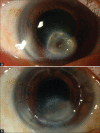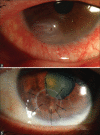Management of corneal perforations: An update
- PMID: 31856457
- PMCID: PMC6951192
- DOI: 10.4103/ijo.IJO_1151_19
Management of corneal perforations: An update
Abstract
Corneal perforation is a potentially devastating complication that can result from numerous conditions that precipitate corneal melting. It is associated with significant morbidity and prompt intervention is necessary to prevent further complications. Causes include microbial keratitis, ocular surface disease, and autoimmune disorders and trauma. Various management options have been described in the literature to facilitate visual rehabilitation. This rview discusses the treatment options that range from temporising measures such as corneal gluing through to corneal transplantation, with decision making guided by the location, size, and underlying aetiology of the perforation.
Keywords: Corneal perforation; infective keratitis; sterile corneal melt.
Conflict of interest statement
None
Figures






References
-
- Lekskul M, Fracht HU, Cohen EJ, Rapuano CJ, Laibson PR. Nontraumatic corneal perforation. Cornea. 2000;19:313–9. - PubMed
-
- Jhanji V, Young AL, Mehta JS, Sharma N, Agarwal T, Vajpayee RB. Management of corneal perforation. Surv Ophthalmol. 2011;56:522–38. - PubMed
-
- Refojo MF, Dohlman CH, Ahmad B, Carroll JM, Allen JC. Evaluation of adhesives for corneal surgery. Arch Ophthalmol. 1968;80:645–56. - PubMed
-
- Kim HK, Park HS. Fibrin glue-assisted augmented amniotic membrane transplantation for the treatment of large noninfectious corneal perforations. Cornea. 2009;28:170–6. - PubMed
Publication types
MeSH terms
LinkOut - more resources
Full Text Sources

